

And USB. Although the Universal Serial Bus (USB) is an integral part of many computers, Java does not officially support USB.
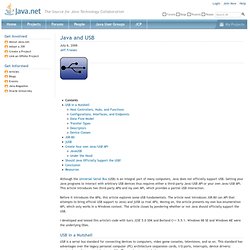
Getting your Java programs to interact with arbitrary USB devices thus requires either a third-party Java/USB API or your own Java/USB API. This article introduces two third-party APIs and my own API, which provides a partial USB interaction. Before it introduces the APIs, this article explores some USB fundamentals.
The article next introduces JSR-80 (an API that attempts to bring official USB support to Java) and jUSB (a rival API). Moving on, the article presents my own bus-enumeration API, which only works in a Windows context. I developed and tested this article's code with Sun's J2SE 5.0 SDK and Borland C++ 5.5.1. USB in a Nutshell USB is a serial bus standard for connecting devices to computers, video game consoles, televisions, and so on. Compaq, Intel, Microsoft, and NEC started to work on the USB standard in 1994.
Host Controllers, Hubs, and Functions Figure 1. Java and Bluetooth. Disclosure Some of the following examples are from: BlueCove - Java library for Bluetooth, Copyright (C) 2006-2007 Vlad Skarzhevskyy Using the Java APIs for Bluetooth Wireless Technology by C.
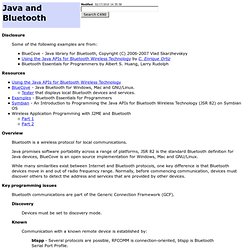
Enrique Ortiz Bluetooth Essentials for Programmers by Albert S. Huang, Larry Rudolph Resources Using the Java APIs for Bluetooth Wireless Technology BlueCove - Java Bluetooth for Windows, Mac and GNU/Linux. Overview Bluetooth is a wireless protocol for local communications. Key programming issues Bluetooth communications are part of the Generic Connection Framework (GCF). Devices must be set to discovery mode. Known Communication with a known remote device is established by: btspp - Several protocols are possible, RFCOMM is connection-oriented, btspp is Bluetooth Serial Port Profile.
A complete specification would be: Unknown Usually the service desired (email, chat, etc.) is known but not device address and port. Programmation Java/Énumérations. Un livre de Wikilivres.
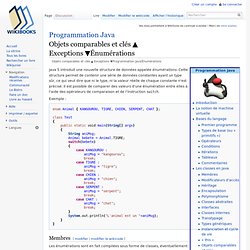
Java 5 introduit une nouvelle structure de données appelée énumérations. Cette structure permet de contenir une série de données constantes ayant un type sûr, ce qui veut dire que ni le type, ni la valeur réelle de chaque constante n'est précisé. Il est possible de comparer des valeurs d'une énumération entre elles à l'aide des opérateurs de comparaison et de l'instruction switch. Using the Java APIs for Bluetooth Wireless Technology. Bluetooth is a low-cost, short-range wireless technology that has become popular among those who want to create personal area networks (PANs).
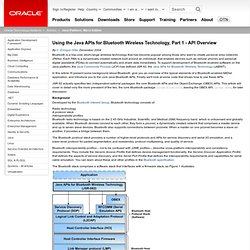
Each PAN is a dynamically created network built around an individual, that enables devices such as cellular phones and personal digital assistants (PDAs) to connect automatically and share data immediately. To support development of Bluetooth-enabled software on the Java platform, the Java Community Process (JCP) has defined JSR 82, the Java APIs for Bluetooth Wireless Technology (JABWT). In this article I'll present some background about Bluetooth, give you an overview of the typical elements of a Bluetooth-enabled MIDlet application, and introduce you to the core Java Bluetooth APIs.
Finally we'll look at some code that shows how to use these APIs. JSR 82 actually specifies two independent optional packages: the core Bluetooth APIs and the Object Exchange (OBEX) APIs. Bluetooth Technology Special Interest Group. Universally Unique Identifier (UUID) short forms The Bluetooth® Service Discovery Protocol (SDP) specification defines a way to represent a range of UUIDs (which are nominally 128 bits) in a shorter form.

A reserved range of 232 values can be represented using 32 bits (denoted uuid32). Of these, a sub-range of 216 values can be represented using only 16 bits (denoted uuid16). All values in the 232 range that are not assigned in this document are reserved pending future revisions of this document. In other words, no value in this range may be used except as specified in this or future revisions of this document.
Bluetooth Class of Device/Service (CoD) Generator. In practice, most Bluetooth clients scan their surroundings in two successive steps: they first look for all bluetooth devices around them and find out their "class".
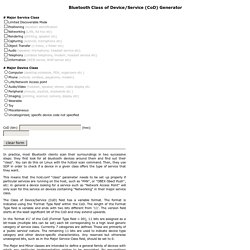
You can do this on Linux with the hcitool scan command. Then, they use SDP in order to check if a device in a given class offers the type of service that they want. This means that the hcid.conf "class" parameter needs to be set up properly if particular services are running on the host, such as "PAN", or "OBEX Obect Push", etc: in general a device looking for a service such as "Network Access Point" will only scan for this service on devices containing "Networking" in their major service class.
The Class of Device/Service (CoD) field has a variable format. The format is indicated using the 'Format Type field' within the CoD. Connecting to Bluetooth devices with Java. Url?sa=t&rct=j&q=&esrc=s&source=web&cd=1&ved=0CDMQFjAA&url=http%3A%2F%2Fmokik.googlecode.com%2Ffiles%2FBluetooth-jsr-82-training.pdf&ei=w6AcUojNMuuR7AbfoYCYCA&usg=AFQjCNGo9UkWUyooleHbxUxXDTmOjMB7hA&sig2=2WLwMmlg4kePA2gYDQdYeA&bvm=bv.51156542,d. Bluetooth Class of Device/Service (CoD) Generator.